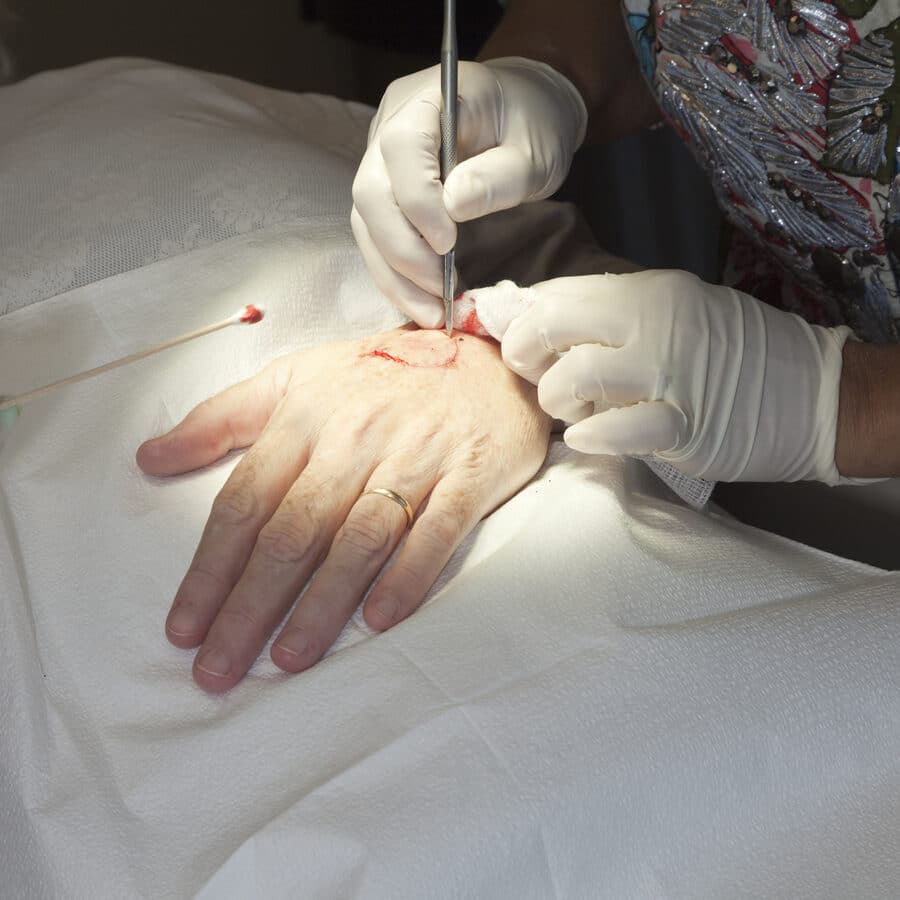Mohs micrographic surgery is a specialized surgical procedure considered the gold standard for the treatment of skin cancers located in areas where tissue sparing is of the utmost importance, such as the head and neck.

Unfortunately, skin cancer remains one of the most common forms of cancer, with more than two million people diagnosed with a form of skin cancer annually. If you have had sunburns in the past, have used tanning beds, have a fair complexion or a family history of skin cancer, you may be at a higher risk for developing skin cancer. No matter the type of skin cancer, finding the spot before it becomes a larger issue is important. If not diagnosed and completely removed, skin cancers may grow indefinitely.
The Mohs technique offers several advantages over traditional skin cancer removal treatments:
Mohs surgery has the highest cure rate; close to 99% for primary tumors, and close to 94% for recurrent tumors.
Mohs surgery preserves healthy skin surrounding the tumor, minimizing final wound size once the skin cancer is removed, and thus allowing for an optimal cosmetic result.
The procedure is performed in an outpatient setting with local anesthesia, typically in one visit.
Typically, the average skin cancer requires one to two stages to clear and patients spend four to six hours in the office. However, depending on the number of stages and length of the surgical repair, some patients may spend a longer time in the office. Since this cannot be predicted ahead of the procedure, please be prepared to potentially spend the entire day in the office.
Do NOT discontinue the medications listed below (unless explicitly instructed by the prescribing physician):
Ten days prior to the surgery, discontinue the medications listed below. This will decrease the risk of bleeding during and after the surgery:
Two days prior to the surgery, avoid drinking alcohol. This will also decrease the risk of bleeding during and after the surgery. Avoid smoking prior to and after the procedure, as it can affect your healing.
For surgeries on the legs, please obtain medical grade compression stockings (20-30 mm Hg). You may ask your pharmacist to assist you in determining your correct size. If you can’t tolerate compression stockings, a flexible “cast” (Unna boot) can be placed in the office instead.
In some instances, your surgery may impair your ability to drive. It is always a good idea to have a driver available although in most instances it will not be necessary.
It is a good idea to bring medications, snacks/lunch, and something to occupy your time (books, tablet, laptop, etc.). Make sure you have no other commitments or appointments on the day of the surgery.
Mild to moderate pain is expected after the surgery, and usually resolves after 48 hours. Pain can be controlled by using over-the-counter Tylenol (acetaminophen) or another pain killer prescribed by your Mohs surgeon. Bruising and swelling are common following surgery (especially if around the eyes), and usually last five to seven days before resolving. Please be advised this could interfere with social engagements for several days. Applying ice during the first 24-hours after surgery reduces bruising, swelling and pain.
As with any surgical procedure, you will be left with a scar. The goal is for the scar to be as subtle as possible once completely healed, and every effort will be made to offer the best possible cosmetic result. It is important to consider that the scar may appear longer than what you may have anticipated, since the skin cancer may extend beyond what is visible on the surface of the skin before the surgery is performed. The scar may also need to be lengthened to better fit the contours of the skin. Detailed wound care instructions will be given to you on the day of the procedure.
Please be prepared to avoid physical activity for one to two weeks after the surgery for proper wound healing. Strictly following physical activity restrictions will ensure proper wound healing. Most stitches will be removed in the office one to two weeks after the procedure.
Dr. Godinez-Puig is double board-certified in dermatology and in micrographic (Mohs) dermatologic surgery. She is a fellow of the American College of Mohs Surgery (FACMS), and a fellow of the American Academy of Dermatology (FAAD. Dr. Godinez-Puig has practiced Mohs surgery and general dermatology in private practice for over five years in the Chicago suburbs.
